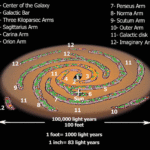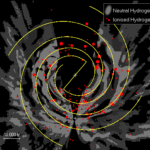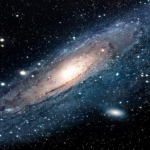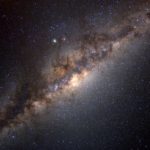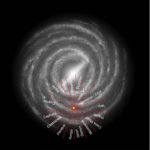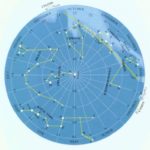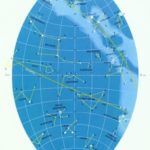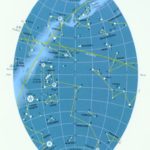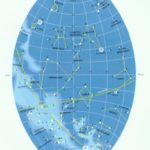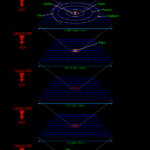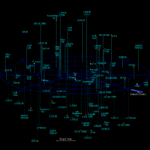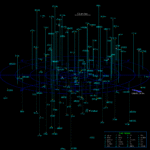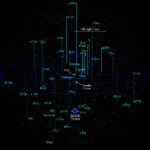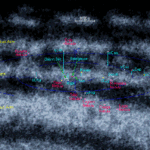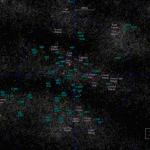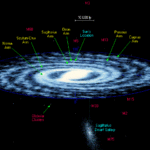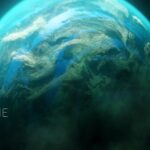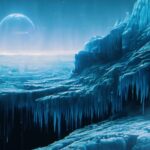All relevant information about our home-galaxy will be here.
–
Table of Contents:
- Introduction
- Directory of Planets by Saga
- Maps (Images Begin)
- Featured Solar-systems
- Featured Worlds
- 2023 September/+
–
Introduction:
Our home galaxy is a vast swastika-like spiral thought to have started forming 13.2 billion years ago, it measures 120,000 light-years (LY) (diameter) by 30,000 LY (depth of the core) to 1,000 LY (depth of the ends of the spiral arms), and includes hundreds of billions of stars (estimated between 100 and 400 billion), most of which are the cores of vast solar systems full of worlds. Even if only 1% of those worlds were habitable for lifeforms such as Earth’s humanity, that’s still 1 to 4 billion Earth-like planets and moons. Current estimates and findings indicate closer to 22-25% of the stars in our galaxy have at least one planet in their habitable zone, though; as many as 100 billion stars and perhaps a trillion worlds.
- Zoom in and out of the entire galaxy, all the way in to our solar system, and all the way out to the edge of the outer spiral arms: Star Chrome Experiment.
- Take a look at all of the thousands of real planets confirmed by the Kepler Tally.
- What’s going on in the heart of the Milky Way Galaxy (MWG)? Billions of solar systems, greater illumination, and super-massive black-holes await. Here is the core of the MWG.
So far we have named ~9,000 planets in the Milky Way.
–
Directory of Planets by Saga:
- Alien Nation: Slaves being shipped across a Space lane crash-landed landed on Earth and had no choice but to attempt integration in human society, resulting in their own racial segregation and struggle for equality.
- Andromeda: A system dealing with three of the closest galaxies is the central hub of activity for a Commonwealth attempting to maintain its utopian stance while dealing with an intergalactic species dedicated to war.
- Babylon 5: People from many worlds across the Milky Way interact on this famous Space station.
- Battle Tech: This includes Battle Mech, Battle Space, and Mech Warrior.
- Battlestar Galactica: Humanity’s A.I. robots; the Cylons, declare independence in a sudden attack against many colonies far away from Earth, and the surviving humans band together on a single spacecraft carrier.
- Blake’s 7: Falsely convicted people escape from prison, commandeer a derelict spaceship, learn about alien cultures far out into Space, and launch a campaign against the totalitarian government of their time.
- Childe Cycle / Dorsai Series: Humanity has colonized 14 worlds at this time, and is diverging into distinct alien races, each with their own culture and specialization(s), with trade focusing on their specialties, somewhat leaving the less specialized people of Earth behind.
- CoDominium: When the U.S. and U.S.S.R. allied and ruled the Earth for a century, Space colonization increased while scientific and political evolution stopped, and the militarized forced relocation of many people from Earth to the colonies is maintained due to the growing belief in a coming global holocaust.
- Cthulhu Mythos: There are worlds still often inhabited by gods and other ancient beings.
- DC Comics: A lot of the heroes you know from this series had their origins on other planets, others at least briefly traveling there.
- Dune: Here are the worlds involved in the trade of Spice which allows for creature-based interstellar-drives.
- Dungeons & Dragons: Endless interactive scenarios are presented from the setting of several worlds and planes of existence, each one dealing with hostile beings, social interaction parameters, and the effects of the given environments on each person.
- Ender’s Game: Earth has been attacked twice by an insectoid species, and humanity has ramped up its efforts in hopes of preventing the anticipated third attack.
- Farscape: An astronaut unexpected transported through a worm-hole to an unknown part of the Milky Way learns to work with a very dynamic and barely compatible team aboard a living starship.
- Firefly: The worlds of the 34 Tauri solar-system are heavily colonized and now dealing with their own Civil War, this one on an interstellar scale.
- Forever War, The: Generations of Space warfare leads to incredible advancements in both technology and evolution.
- Foundation Series: A.I. operating-code fundamentals, and humanity’s digital transcendence, affect many worlds across the Universe.
- Hainish Cycle: Civilizations of human beings on Earth and planets orbiting a number of nearby stars are contacting each other for the first time in Ages, and establishing diplomatic relations, setting up a confederacy under the guidance of the oldest of the human worlds, peaceful Hain. Humanity’s origins on other worlds, the result of interstellar colonies planted by Hain long ago, followed by a long period when interstellar travel ceased, is touched upon. Some of these human races have new genetic traits, a result of ancient Hainish experiments in genetic engineering, including people who can dream while awake, and a world of people who only come into active sexuality once a month.
- Hal Clement: A dozen worlds with vastly different characteristics are discussed.
- Halo: worlds contested and sometimes glassed by The Covenant
- Heinlein: The worlds here are featured in Citizens of the Galaxy, Starman Jones, Starship Troopers (the great books, not the awful movies that had little at all to do with them), Time Enough for Love, Time for the Stars, and Tunnel in the Sky.
- Heritage Universe: After humanity colonizes most of the worlds in our spiral arm of the Milky Way, a series of immense engineering artifacts constructed by an ancient race referred to as The Builders are found and studied.
- Honorverse: These are the worlds of the main series, its two sub-series, two prequel series, and anthologies created by David Weber. They are centered on the Space Navy career of the principal protagonist Honor Harrington.
- Human Empire: Eons after the rise and migrations of Inisfree, these worlds are touched upon in the saga of the protagonist Aorlie.
- Humanx Commonwealth: An interstellar ethical/political entity called The Commonwealth takes its name from its two major sapient species, who jointly inhabit Commonwealth planets and administer both the political and religious/ethical aspects. They are the mammalian Humans of the planet Earth and the insectoid Thranx of the planet Hivehom. The Commonwealth is described as a progressive, well-intentioned liberal democracy spanning many star systems, and is somewhat similar to the United Federation of Planets from Star Trek. The Humanx Commonwealth is notable for its portrayal of a human–alien relationship that is not just mutually beneficial but symbiotic, allowing an amalgamation of the two species.
- Hyperion Cantos: Several worlds are included, with Hyperion being the start and focal point, and Earth being the end.
- Kepler Tally: Worlds confirmed and made public by various scientists are added here.
- Known Space: This region spans 60 LY across, and is centered around the Sun. It includes dozens of solar systems recently colonized by humanity. A few worlds and systems beyond it are mentioned in the series.
- Lensman Series: Numerous solar systems are visited by the newest wearer of a tool called The Lens, which bestows various abilities, such as mind-reading, bridging language barriers between alien species, and making it easier to enforce the law on foreign worlds.
- Lexx: Worlds in two universes are encountered and dealt with, including Earth and a parody of it.
- Lost Planet: E.D.N. III is going through an ice age, and is contested by various alien and indigenous creatures.
- Marvel Comics: A lot of the heroes you know from this series had their origins on other planets, others at least briefly traveling there.
- Mass Effect: Here are the hundreds of worlds connected by the Mass Relays and threatened by the Reapers.
- Night’s Dawn Trilogy: Nearly 900 worlds are colonized by humanity in the 27th century.
- Noon Universe: 20 worlds interacting with the Progressors and others of Earth, as well as the Wanderers.
- Oikumene: A dozen worlds spread across half a dozen solar systems.
- Perry Rhodan: most successful (well-selling) science fiction series in Earth-human history –so far (as of 2024)
- Phantasy Star: 4 worlds in the Algol system.
- Pitch Black: 59 worlds involved in the Riddick adventures are spread out across nearly as many solar systems.
- Predator: Worlds used by the Yautja, such as Earth, Game Preserve Planet, and Yautja Prime.
- Revelation Space: 14 solar systems plus other locations, including the planets Ararat, Cerberus, Resurgam, Sky’s Edge, and Yellowstone.
- Robotech: 20 worlds, including the Earth.
- Saga of Seven Suns: Many worlds across the Milky Way’s local spiral arm are described, including one still covered in World Trees (like those in World of Warcraft), its people still able to communicate telepathically/psychically across Space when touching even their saplings.
- Sigilverse: After the Atlanteans largely transcended to another plane of existence, humanity developed for 300 centuries without them; 14 main worlds the humans now occupy are covered here.
- Space Battleship Yamato: A couple dozen planets are featured in this series.
- Star Trek: Thousands of worlds across the Milky Way and beyond are mentioned here.
- StarCraft: Dozens of worlds in the Koprulu Sector of the Milky Way are in this saga.
- Stardoc: A dozen homeworlds of the various major species in this series are hinted at.
- Stargate: 15 prominent worlds and hundreds of others are listed.
- Three Worlds Cycle, The: Aachan, Santhenar, and Tallallame.
- Time Quartet: (now Quintet) Camazotz, Earth, Ixchel, and many other worlds mentioned.
- Total Annihilation: The decimation of a million worlds is mentioned in the opening; perhaps a hundred million are involved in this story.
- Transformers: Nearly 100 worlds are involved in this series.
- Uplift Universe: Virtually countless worlds spanning five galaxies are mentioned, with a couple dozen specifically named, and a focus on Earth and those of Earth who have had their evolution assisted on that world.
- Vorkosigan Saga: Dozens of worlds in a group of solar systems known collectively as the Wormhole Nexus.
- WarCraft: Earth was called Azeroth, and then there was Draenor. Some of these worlds are beyond the Milky Way, though.
- Warhammer: Thousands of worlds across the Milky Way, as they are in the 41st millennium, A.D.
The Webway that connects them all.
–
Maps:
–
Featured Solar-systems:
–
Featured Worlds:
Here are some of the more interesting/exotic planets in this galaxy.
–
2023 September/+:
–
Also see:
- comparison of cosmic objects from tiny (asteroids) to gigantic (SMBHs)
- The Real Star Locations and Scale of Sci-fi
- largest known planet: gas-giant “HD 100546 b” (almost as big as the Sun)
–


